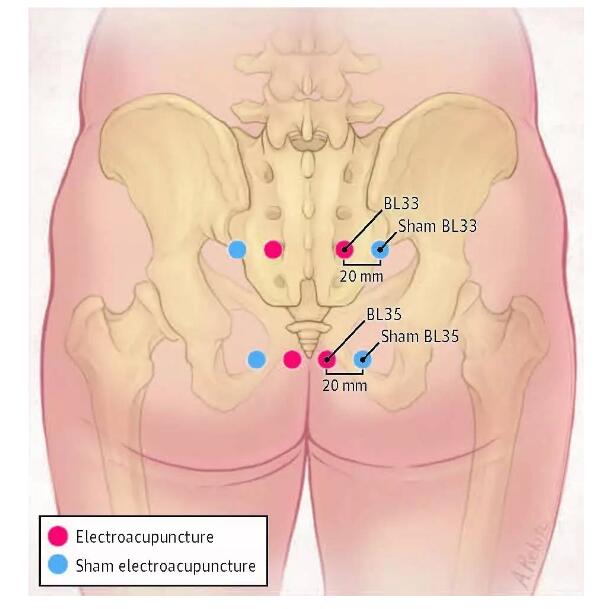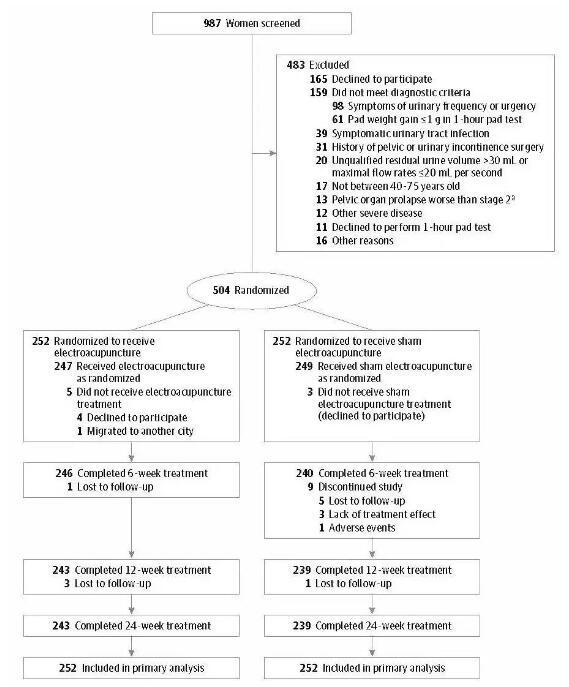Results of Liu Baoyan’ Team 1ST Published in JAMA(IF44.405)
International medical journal the Journal of the American Medical Association, JAMA published full-text research report of Effect of Electroacupuncture on Urinary Leakage Among Women With Stress Urinary Incontinence: A Randomized Clinical Trial led by CACMS Lead Researcher Liu Baoyan and Chief Physician Liu Zhishun online on 27th, June. This research proved that electroacupuncture involving the lumbosacral region is effective in reducing urine leakage for women with stress urinary incontinence through randomized clinical trial including over 500 cases, providing new therapy for patients.

Stress urinary incontinence, the complaint of involuntary leakage during exertion, cough or sneeze, result in a serious psychological burden of patients with a decline in quality of life, of which 2017 American Urology Institute Guidelines reports that the incidence rate up to 49%. The current recommended conservative treatment is pelvic floor muscle training, severe cases require surgical treatment. Previous clinical studies show that acupuncture has certain effect on treating female stress urinary incontinence but limited by causes like small sample size of clinical research and low research quality, it still lacks strong evidence to support effect and safety of acupuncture. This research started from 2013, whose project design, development of project-related materials, organization and implementation of the paper and clinical content writing are led by Liu Zhi Shun from Guang'an Men Hospital(GAMH),CACMS; Evaluation Center of Institute of Basic Research in Clinical Medicine(Clinical Evaluation Method Innovation Team of CACMS) is responsible for data management, quality control, statistical analysis and writing related statistical content; Guang'an Men Hospital affiliated with CACMS, Yueyang Hospital of Integrated Chinese and Western Medicine affiliated with Shanghai University of Traditional Chinese Medicine, Dongzhimen Hospital affiliated with Beijing University of Chinese Medicine, West China Hospital affiliated with Sichuan University, Hengyang Hospital affiliated with Hunan University of Chinese Medicine, the First Hospital of Hunan University of Chinese Medicine, First Teaching Hospital of Tianjin University of TCM, ShanXi Hospital of Integrated Traditional and Western Medicine, Jiangsu Provincial Hospital of Traditional Chinese Medicine, Shanxi Traditional Chinese Medicine Hospital, Hubei Provincial Hospital of TCM and Xiyuan Hospital CACMS, departments of acupuncture-moxibustion from 12 hospitals in total, have participated in the completion.

504 female patients with stress urinary incontinence were randomly divided into electroacupuncture group and pseudo-electroacupuncture group (1:1), respectively receiving electroacupuncture and sham electroacupuncture at both side of BL 33 and BL35 no less than 18 sessions (over 6 weeks). 482 patients having completed the treatment, results show that the electro-acupuncture group is significantly better than the sham-acupuncture group on reducing leakage and improving the quality of life. The difference is of clinical significance that the efficacy lasts for 24 weeks after suspending the treatment and adverse events rarely occur during treatment. This study proves the clinical efficacy of electroacupuncture in the treatment of female stress urinary incontinence with clinical evidence of high quality.

The reason why this study is able to achieve expected research results, first is the solid clinical basis of acupuncture intervention project, which is closely related to years of previous experience summed up in clinical practice, clinical observation, and constant optimizing of acupoints and manipulations for clinical research of Director Liu Zhishun from Guang'an Men Hospital;Meanwhile, this study applies side treatments of acupoints, shallow needling, and sham electroacupuncture as a control, whose success in playing the role of comfort acupuncture can’t be achieved without careful pre-trial. The study is a another masterpiece of Chinese clinical research team on acupuncture-moxibustion following Electroacupuncture on Severe Functional Constipation: A Randomized Clinical Trial published in US authoritative magazine Annals of Internal Medicine in Sept. 2016. The series of clinical research of the team selects advantages of diseases and recognized efficacy indicators of acupuncture-moxibustion, follows the international practices of clinical research rules, adheres to the scientific, standardized and transparent research attitude from the project design to the implementation process, always takes possible biased control as the focus of clinical research according to the clinical characteristics of acupuncture-moxibustion from operator training, process quality control, patient compliance analysis, etc. to take a series of effective measures; Simultaneously it successfully establishes a clinical research and clinical evaluation methods, data management, quality control, statistical analysis,team collaboration mechanism of research reports writers and China's high-quality, replicable clinical research model of acupuncture-moxibustion in order to lay a solid basis for obtaining more high-quality clinical research evidence of advantages of diseases of acupuncture-moxibustion.
Effect of Electroacupuncture on Urinary Leakage Among Women With Stress Urinary Incontinence: A Randomized Clinical Trial led by CACMS Lead Researcher Liu Baoyan and Chief Physician Liu Zhishun was published in international top journal JAMA at 23:00 p.m. ,Beijing Time last night ( 11:00, a.m., EST, 27th June, 2017 ), which sufficiently reflects the great progress of TCM research in recent years.
Abstract:
[Objective]: To assess the effect of electroacupuncture vs sham electroacupuncture for women with SUI.
[Design, Setting, and Participants]: Multicenter, randomized clinical trial conducted at 12 hospitals in China and enrolling 504 women with SUI between October 2013 and May 2015, with data collection completed in December 2015.
[Interventions]: Participants were randomly assigned (1:1) to receive 18 sessions (over 6 weeks) of electroacupuncture involving the lumbosacral region (n = 252) or sham electroacupuncture (n = 252) with no skin penetration on sham acupoints.
[Main Outcomes and Measures]: The primary outcome was change from baseline to week 6 in the amount of urine leakage, measured by the 1-hour pad test. Secondary outcomes included mean 72-hour urinary incontinence episodes measured by a 72-hour bladder diary (72-hour incontinence episodes).
[Results]: Among the 504 randomized participants (mean [SD] age, 55.3 [8.4] years), 482 completed the study. Mean urine leakage at baseline was 18.4 g for the electroacupuncture group and 19.1 g for the sham electroacupuncture group. Mean 72-hour incontinence episodes were 7.9 for the electroacupuncture group and 7.7 for the sham electroacupuncture group. At week 6, the electroacupuncture group had greater decrease in mean urine leakage (−9.9 g) than the sham electroacupuncture group (−2.6 g) with a mean difference of 7.4 g (95% CI, 4.8 to 10.0; P < .001). During some time periods, the change in the mean 72-hour incontinence episodes from baseline was greater with electroacupuncture than sham electroacupuncture with between-group differences of 1.0 episode in weeks 1 to 6 (95% CI, 0.2-1.7; P = .01), 2.0 episodes in weeks 15 to 18 (95% CI, 1.3-2.7; P < .001), and 2.1 episodes in weeks 27 to 30 (95% CI, 1.3-2.8; P < .001). The incidence of treatment-related adverse events was 1.6% in the electroacupuncture group and 2.0% in the sham electroacupuncture group, and all events were classified as mild.
[Conclusions and Relevance]: Among women with stress urinary incontinence, treatment with electroacupuncture involving the lumbosacral region, compared with sham electroacupuncture, resulted in less urine leakage after 6 weeks. Further research is needed to understand long-term efficacy and the mechanism of action of this intervention.

 World Federation of Acupuncture-Moxibustion Societies
World Federation of Acupuncture-Moxibustion Societies